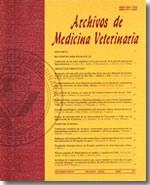Free stall design and dimensions on dairy farms in southern Chile, and its relationship with cow comfort
Main Article Content
Abstract
Uncomfortable stalls and beds reduce the time that cows spend resting and are a risk factor for lameness. In Chile there is little information about the dimensions and bed stalls used for dairy cows. The aim of this study was to determine the characteristics of stalls and beds used for dairy cows in southern Chile. Fifty dairy farms with more than 100 lactating dairy cows were visited. Dimensions and bedding of 1,068 (10%) of all cubicles available, was recorded. Records were entered into an Excel spreadsheet and analyzed using descriptive statistics. Results are presented as percentages, means, ranges and medians. An 84% (42) of the farms housed their cows for five months during winter; an 45.5% (29) of them had more than one stall/cow and 34% (15) had less than one stall/cow. The most frequently used stall-bedding combination was metal stall with mattresses filled with rubber or soil bedding, and wooden stall/soil bedding. More than 70% of cubicles were below the reference values for length of the stall, height of neck rail, height to upper stall division and distance from the wall to neck rail; 45% of stalls had values below the recommended guidelines for the lower stall division. Height of the curb and brisket board exceeded the recommendations in more than 20% of stalls. Dairy farms used mainly night confinement in winter and early spring months. Stalls most commonly used were metallic, North American model. Their dimensions and bedding do not comply with the recommendations of the literature.

